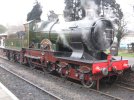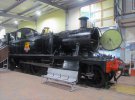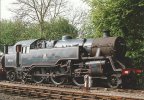-
Welcome to this forum . We are a worldwide group with a common interest in Birmingham and its history. While here, please follow a few simple rules. We ask that you respect other members, thank those who have helped you and please keep your contributions on-topic with the thread.
We do hope you enjoy your visit. BHF Admin Team
You are using an out of date browser. It may not display this or other websites correctly.
You should upgrade or use an alternative browser.
You should upgrade or use an alternative browser.
Steam Locos
- Thread starter Bernard67Arnold
- Start date
Pedrocut
Master Barmmie
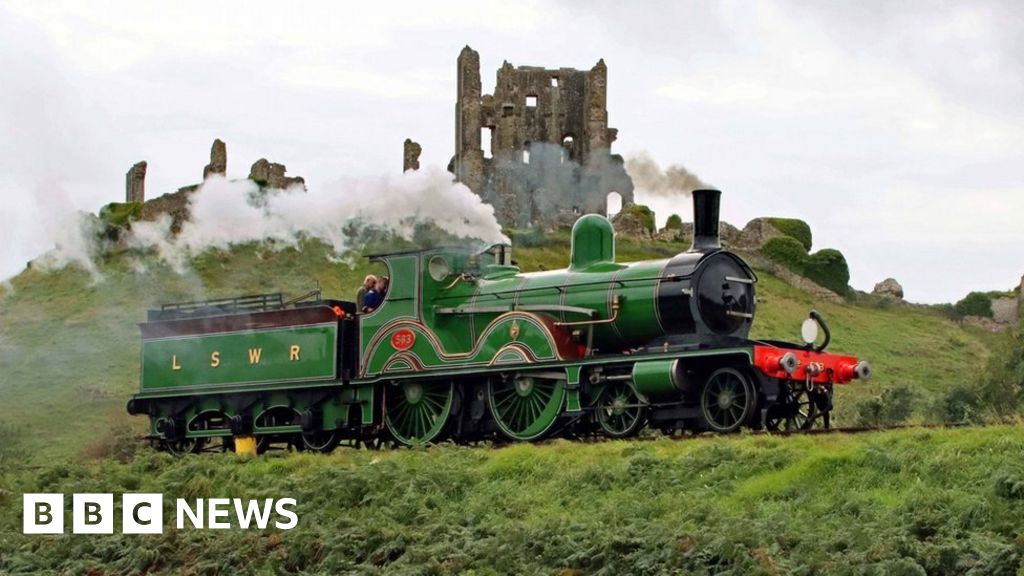
Swanage Railway T3 class No. 563 steam locomotive returns to action
The T3 class locomotive is thrilling passengers once more after being saved from the scrapyard.
www.bbc.co.uk
It's Tyseley. The main line to Warwick, Banbury & Paddington veers off to the left behind the signal box, while the North Warwickshire line to Stratford & Cheltenham goes off to the right. The train is non-corridor stock, meaning it's probably a suburban working, maybe arriving from Lapworth before terminating at Snow Hill? Period probably late 1950s.Trying to identify location on attached pic and then rough age. I want to see if I can find the copyright owner
Ta
pulled by a Prairie x 5 in my layout shedsIt's Tyseley. The main line to Warwick, Banbury & Paddington veers off to the left behind the signal box, while the North Warwickshire line to Stratford & Cheltenham goes off to the right. The train is non-corridor stock, meaning it's probably a suburban working, maybe arriving from Lapworth before terminating at Snow Hill? Period probably late 1950s.
Brake coach in middle of rake !
Post January 1948 early emblem on loco
Last edited:
Lloyd
master brummie
I thought about the brake coach being in the middle, but it suits situations where the loco runs round the train at an outer terminal to run back the other way. It would seem pointless to have a brake / guards compartment next to the engine.pulled by a Prairie x 5 in my layout sheds
Brake coach in middle of rake !
Post January 1948 early emblem on loco
yes i thought about that im running x6 suburban trains x4 into termiul stations most of my pictures of GWR/LMS Suburban rakes 3 plus cars have a brake both ends the guard has to apply the brakes when neededI thought about the brake coach being in the middle, but it suits situations where the loco runs round the train at an outer terminal to run back the other way. It would seem pointless to have a brake / guards compartment next to the engine.
Iv watched this been done as a kid rideing in a brake coach with my uncle Jack during the summer hols
he was a ex GWR driver but due to a injury he became a guard
thats when i caught the bug
got 2 GWR and BR/WR lamps on fire place.
Radiorails
master brummie
'B' sets were usually two carriages each with a brake at each end, They were familiar on branch lines and could be made up as fours if required.
In the Birmingham Division, of GWR, they were known as 'D' sets and were made up of longer sets of carriages.
In the Birmingham Division, of GWR, they were known as 'D' sets and were made up of longer sets of carriages.
Richard Dye
master brummie
Great video! Hydrogen has become a power source for many diesel conversions. Many of the locos used on the Austrian National Railways have already been converted and diesel engine manufacturers are building engines that are backward compatible. Not sure where the steam part plays in this because many conversions generate electricity to utilize existing technology, maintenance and servisabilty.Is Steam on the way back ?
Lloyd
master brummie
Steam has an advantage over electricity in that it is compressible. Electricity needs batteries to store power, but steam at high pressures always wants to return to atmospheric pressure, hence it holds latent energy which can be transmitted to the machinery it is driving.Not sure where the steam part plays in this because many conversions generate electricity to utilize existing technology, maintenance and serviceability.
Richard Dye
master brummie
Hydrogen/ electrics do not need larger batteries. The electricity is generated by hydrogen generators which travel with the vehicle. The hydrogen is highly compressed in tanks on the loco an$ is the power source.Steam has an advantage over electricity in that it is compressible. Electricity needs batteries to store power, but steam at high pressures always wants to return to atmospheric pressure, hence it holds latent energy which can be transmitted to the machinery it is driving.
Richard Dye
master brummie
And that is a very good thing about hydrogen!Thank goodness for the strategic reserve...
Richard Dye
master brummie
This link is a little primmer, if you want more I will glad to oblige. The waste or by product is water vapor. The big breakthrough is currently known as green hydrogen. From the article batteries are not needed in the process. It is renewable energy & as I said earlier a number of locomotive operators have already converted to hydrogen. Water is H20 that is where the hydrogen comes from.
Toyota & Honda (and I am sure others) are developing hydrogen powered vehicles, the recharge tome is 90 to 100 seconds vs 11/2 to 2 hours for EV.
I'm a bit confused by this, and by what Richard says. I thought hydrogen was normally made by electrolysis or by some thermal process from fossil fuels. It can be stored either high pressure or by absorption on (usually very expensive) substrates. So not clear how it can be generated on the locomotive without either using electricity generated elsewhere (and presumably stored on the loco) or from fossil fuels. I don't claim to be very knowledgeable on the subject and am probably not up to date, so could someone explain how it is generated in this environment?
Richard Dye
master brummie
A little more from Germany showing the charging station...........
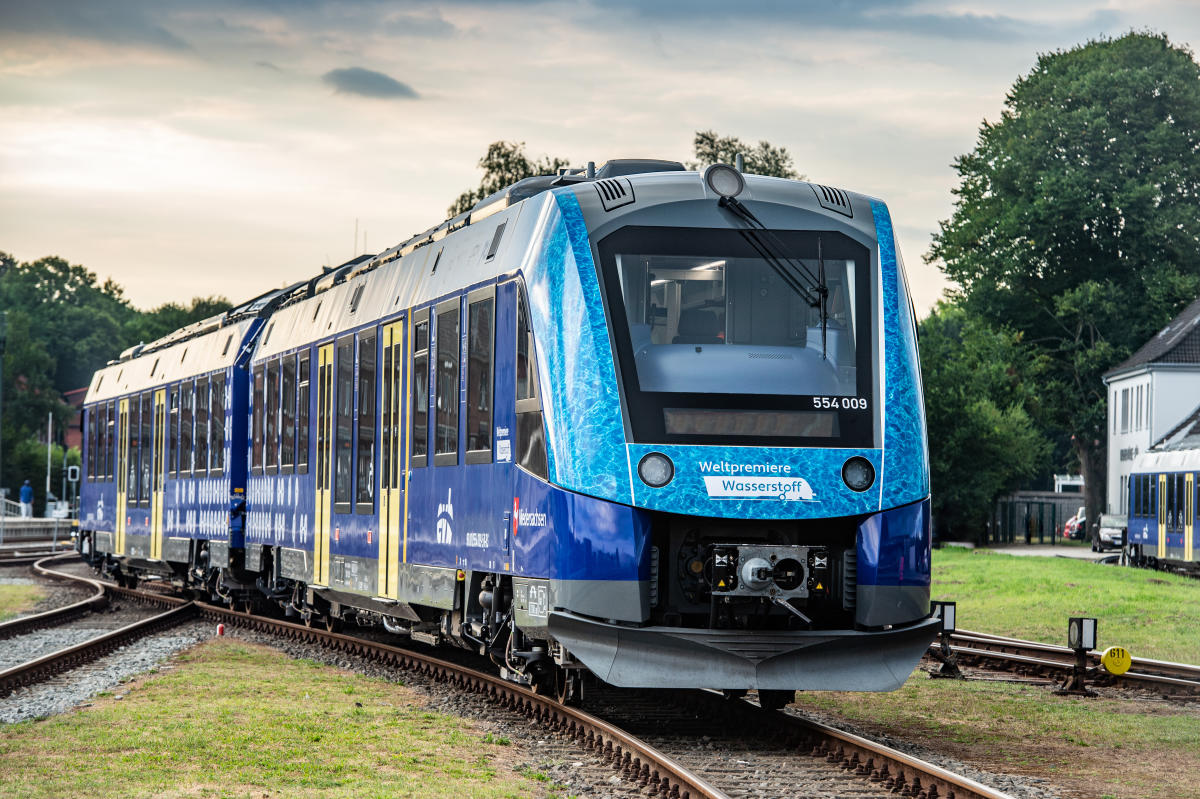
 www.engadget.com
www.engadget.com
The first fully hydrogen-powered passenger train service is now running in Germany
Alstom's Coradia iLint trains only emit steam and condensed water.
Richard Dye
master brummie
This is from Cummins, in full disclosure I worked at Cummins, Global Operations. This has some excellent background and detail for most readers. Cummins is the largest manufacturer of engines (not vehicles). Hope this helps.
Richard Dye
master brummie
Green hydrogen uses solar & wind, grey hydrogen uses fossil fuels. Look at the like from Germany and the Cummins link, they should clear up you question Mike.I'm a bit confused by this, and by what Richard says. I thought hydrogen was normally made by electrolysis or by some thermal process from fossil fuels. It can be stored either high pressure or by absorption on (usually very expensive) substrates. So not clear how it can be generated on the locomotive without either using electricity generated elsewhere (and presumably stored on the loco) or from fossil fuels. I don't claim to be very knowledgeable on the subject and am probably not up to date, so could someone explain how it is generated in this environment?
Lloyd
master brummie
...and what would the (solar, wind or fossil) fuel requirement be to generate enough Hydrogen to run a fleet of, say, 20 locomotives in daily service?Green hydrogen uses solar & wind, grey hydrogen uses fossil fuels. Look at the like from Germany and the Cummins link, they should clear up you question Mike.
is it economically cheaper than using that power directly via overhead wires to electric trains? If so, it would be a game changer.
Richard Dye
master brummie
Lloyd, I don’t have those answers and if I did could not share. I will say this if you read the articles you will see enormous interest and participation. This approach eliminates tho cost and maintenance of electrification particularly in remote areas....and what would the (solar, wind or fossil) fuel requirement be to generate enough Hydrogen to run a fleet of, say, 20 locomotives in daily service?
is it economically cheaper than using that power directly via overhead wires to electric trains? If so, it would be a game changer.
There is no “silver bullet” to the carbon zero goal but hydrogen is certainly a part of that with the ability to reuse existing diesel engines and maintenance technologies.


